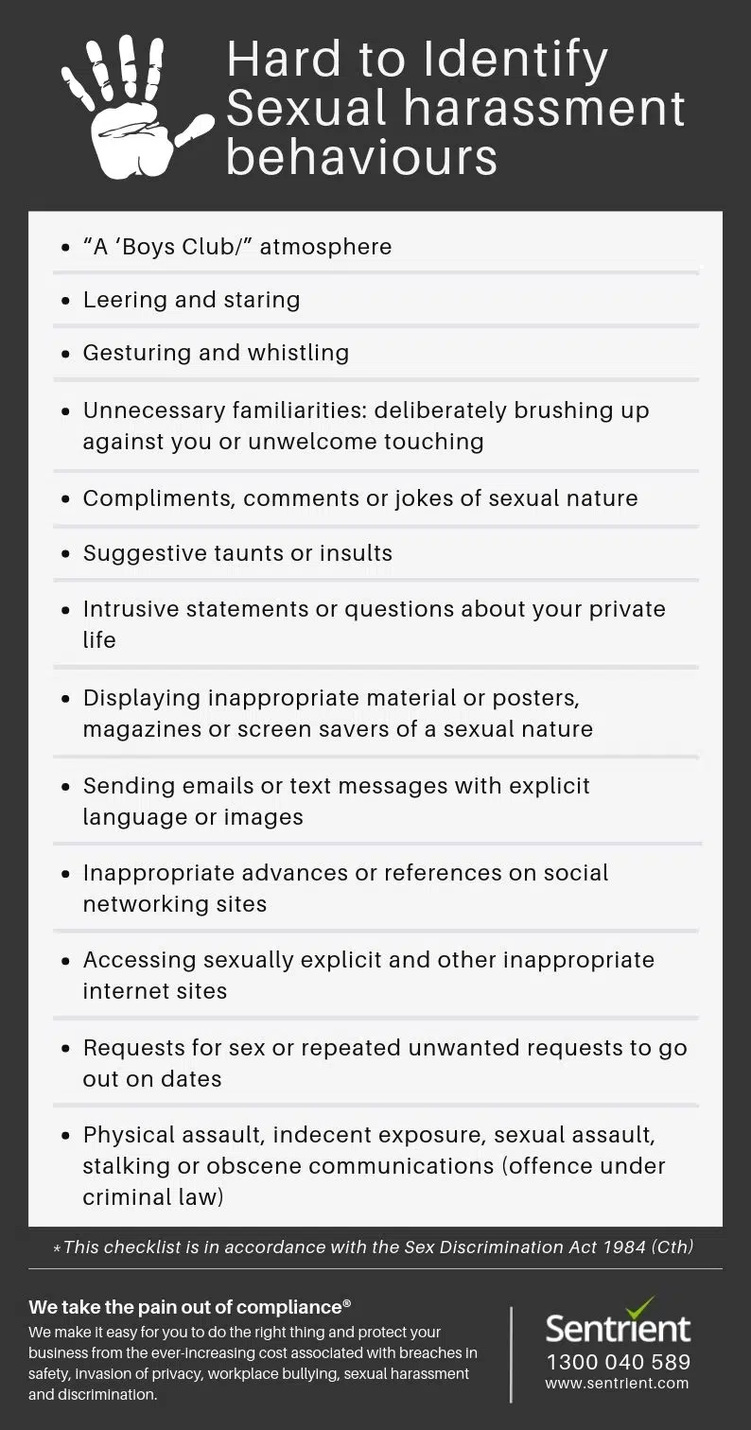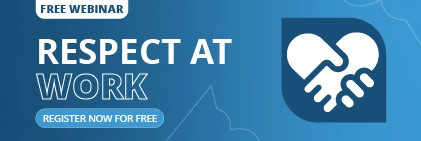Sexual harassment in the workplace is detrimental to the mental health and well-being of an individual or individuals who experience such acts of misconduct. It can also have a catastrophic downside for a business by way of lost revenue, claims for legal liability, irreparable brand damage and the destruction of shareholder value.
Furthermore, the hidden costs of sexual harassment include increased staff turnover, plummeting employee engagement, decreased productivity and an underlying sense of lost control and unsafe practices.
A Responsible Employer is a Safe Employer
As a responsible employer, you are obliged to create a workplace for your employees, contractors and volunteers that is safe, all-inclusive and healthy. This encourages people to speak up in the event that a colleague conducts themselves in a way that does not comply with your code of conduct and professional standards. Yes, as a responsible employer, you are required to set and maintain such standards, and this will ensure that your staff is the best they can be!
The Gravity of the Situation
According to the fourth national survey of the Australian Human Rights Commission, 39% of all working women have experienced sexual harassment in Australian workplaces. What often goes unquoted is that 29% of all working men have also experienced sexual harassment in the last five years. The issue we are talking about here impacts men and women of all ages, all backgrounds and at all levels of seniority within an organisation.
Unfortunately, sexual harassment in Australian workplaces is still on the rise, and this is something that should not be taken lightly. One in three workers in Australia said that they had been subjected to sexual harassment at work in our 2018 survey, compared with one in five from our 2012 and 2008 surveys and one in ten from our 2003 survey, said Sex Discrimination Officer Kate Jenkins.
An Interesting (and Most Unfortunate) Finding
The most important and interesting statistic these reports show is the number of people who said that they had not experienced sexual harassment as per their understanding of the legal definition and then went on to report having experienced behaviours that did constitute sexual harassment. This talks about the lack of education and understanding about what is and what is not sexual harassment in the workplace.
Legal Definition Vs. Actual Behaviour
This was the definition which was shown first:
Sexual harassment is an unwelcome sexual advance, unwelcome request for sexual favours or other unwelcome conduct of a sexual nature which, in the circumstances, a reasonable person, aware of those circumstances, would anticipate the possibility that the person would feel offended, humiliated or intimidated.
Respondents denied having experienced workplace sexual harassment.
This was followed by questions like:
- Did anyone at your workplace inappropriately stare at you that made you feel uncomfortable and offended
- Any repeated invitations to go out on dates by colleagues or seniors
- Did anyone ask you about your sex life, or talked to you sexually under the facade of being friendly that you felt was inappropriate and intrusive
- Any casual pat on the body, that wasn’t casual to you
- Any leading or sexually explicit SMSes, tagging or Email, during or after work hours
- Explicit gifts or jokes that made you feel uncomfortable
Of those people surveyed, most had experienced these misconducts either directly or indirectly. It was found that in many such cases, it was felt that those actions were, in fact, lawful and that what had happened was just a once-off or an unfortunate event or mistake that had been made. This shows us that there is a gap in information, and the Australian workforce needs to know their rights better. There is a significant gap in terms of what actually happens in the workplace when it comes to sexual harassment and what is reported through the chain of command or to HR representatives who are able to support situations like this.
How Big is the Difference?
In 2008, 22% of people who said they had not experienced sexual harassment on the basis of the legal definition then went on to report having experienced behaviours likely to constitute sexual harassment, compared with 18% of people in 2012 and 29% of people in 2018.
The latest survey of 2018 by AHRC says that almost half – 49% of respondents said they had not experienced sexual harassment when shown the legal definition and later went on to say that they were, in fact, subjected to sexual harassment behaviour.
Sentrient’s List to Help Identify Sexual Harassment
Sexual harassment can take many different forms in the workplace, and it can be obvious or indirect, physical or verbal, repeated or one-off and perpetrated by males and females against people of the same or opposite sex.

The key to education on sexual harassment, such as the online courses provided by Sentrient, who are Australia’s #1 provided of harassment, bullying and discrimination-related training to support initiatives with regard to Workplace Gender and Equality in the workplace, is that once employees can see the problem as a problem, they can address it. Such steps to identify, report and resolve are included in your organisation’s anti-bullying, harassment and discrimination policies to accompany important education on these topics.
Did you find this blog of interest? You may also like to view our blog on Why is Sexual Harassment training so important for your employee?
Falling short when it comes to up-to-date and relevant Sexual Harassment education and training. Get a free demo from Sentrient today. You can also reach out to our friendly team at [email protected] or call us on 1300 040 589. We will be happy to help you do the right thing in business.
Read More About Sexual Harassment:
- The Duty of a Supervisor and Manager to Eliminate Sexual Harassment in The Workplace
- 7 Steps To Investigate A Complaint of Sexual Harassment In The Workplace
- New Compliance Course Released – Preventing and Responding to Sexual Harassment for Supervisors and Managers
- Brave Leaders Stand Up to Sexism and Bullying Behaviour
- Hard to identify examples of sexual harassment in the workplace: The uncomfortable work meeting





